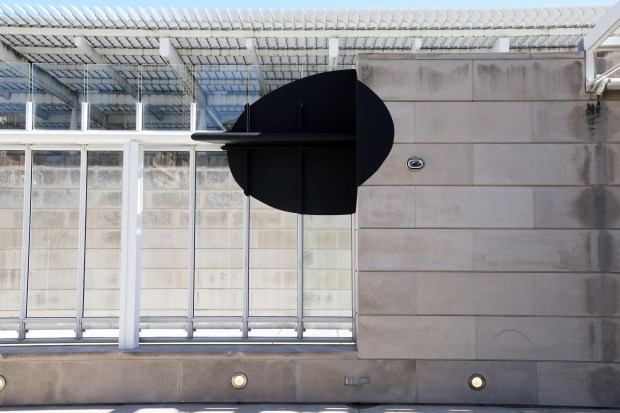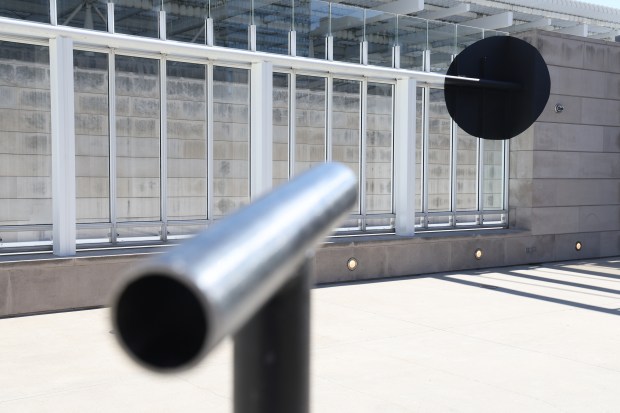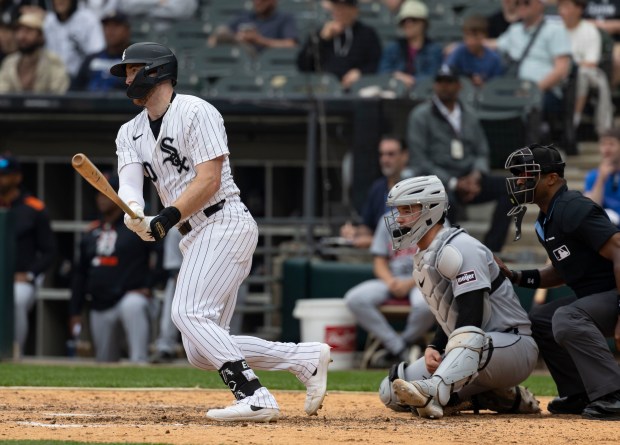Right now, at the Modern Wing of the Art Institute of Chicago, on the Bluhm Family Terrace looking out over Millennium Park and skyscrapers along Michigan Avenue, there is nothing. No, no, wait, make that: There is something that resembles nothing. An exhibition, that looks like nothing much at all. It’s composed of four works from the late Nancy Holt. If you’ve never heard the name (or know a minimalist art installation when you see one), you’d miss it. And that, in itself, nicely explains one of the preoccupations of Nancy Holt.
She liked forcing you to think about how observant you were. She made you recognize your perception. She wanted you to notice. She did this many ways for decades. What the Art Institute is showing through April was maybe her simplest way: Holt, who died in 2014, welded steel pipes to look through. Ever played pirate using a cardboard roll for a spyglass? It’s a reductive description, but picture that, it’ll point you in the right direction.
Holt was fascinated with the way an artist could direct the viewer’s eye to the overlooked and unnoticed. Her subject was the act of seeing, sometimes through optical tricks. That might sound silly, but understand Holt made these works with wit. She dubbed the seemingly simple pipes “Locators,” describing them as “lensless telescopes” and “filmless cameras.” Sometimes, said curator Caitlin Haskell, she would tell people that her works were not so much sculptures to look at but sculptures to look through.
Haskell, who spent years negotiating with Holt’s foundation and getting these installations just right for display at the Art Institute, spoke excitedly, walking out to a corner of the terrace where a Locator stood. It resembled a mic stand without the mic.
“This,” she said, “is complex.”
This doesn’t look complex, I said.
“Which is what I love about it,” she said, inviting me to look through one end of the pipe. “Out here is an almost entirely empty terrace, yet look though it, into that corner, and…”
Whoa. Magic trick. Peer through the pipe, you realize it’s been arranged, angled just so, raised to such an specific height that a small elliptical oval painted onto a corner of the terrace floor that curls up from the floor and over a limestone ledge — well, look through the pipe and the oval loses its oblong shape. It becomes a perfect circle. Holt called this “Locator P.S. 1.” Nearby is “Dual Locators,” one of Holt’s first Locators: It’s made of two pipes, a mirror and an extremely black hole painted on the terrace’s limestone wall. I’ll let Haskell explain: “This one contains a mirror of predetermined diameter, and what happens when you look though this aperture — go ahead, you’re welcome to do it, look through — and what you see forms a perfect circle on that wall. Get your eye a bit closer and now you see it forming the faintest halo of light — maybe almost an eclipse effect.”
Haskell smiled like a magician, satisfied.
“You come out onto the terrace, you go ‘What the hell am I looking at?’ It’s inviting you, yet there are no instructions for what to do, then it all comes together. We liked how stark this looks, yet it’s actually a complex arrangement of perception and architecture.”

As Holt liked to tell people, her personal motto was lifted from Emily Dickinson:
“My business is circumference.”
Holt is remembered as a pioneering land artist, making destination works that played off the natural environment. She was an East Coaster who gravitated to the American West and became best known for “Sun Tunnels,” huge concrete cylinders she stationed in the Great Basin Desert of Utah; and “Holes of Light,” an inside piece consisting of a single wall spotted with eight holes and arranged beneath lights set on timers that alternated bright and dark, projecting a cascade of lunar-like crescents on gallery walls. Again, a kind of light trick. Holt, naturally, started as a photographer and filmmaker, but worked in poetry and performance. Haskell, who curates modern and contemporary art for the Art Institute, became enamored of Holt’s work when she was a graduate student in Texas. She would visit Holt’s “Time Span,” installed in an Austin sculpture park. Every year on April 5 (Holt’s birthday), the slant of the afternoon sunlight against its steel target-like shapes perfectly frames a plaque noting the completion date of the work — also April 5.
Many of Holt’s Locators were shown almost exclusively indoors until Haskell put two on the museum terrace. Holt made her first in 1971 and continued welding Locators for another nine years. She used them to frame neighborhood windows and rooftops and Montana ranch land. She made “Locator with Spotlight and Sunlight” and “Locator with Mirror” and “Locator (Cracked Window)” and “Locator (Studio Corner),” among others.
Just inside the Bluhm Family Terrace are two Locators from 1971.
“They seem a little sculptural fixed to the floor here,” Haskell said.
I didn’t know what she was referring to, then there — micless mic stands of sorts. “Locator (Exhaust Pipe),” facing east, is trained on the roof of the museum’s Rubloff Building. “Locator (Two Windows),” facing west, looks across the train tracks between the Modern Wing and the blocky backside of the Ferguson Memorial Building. I peeked through the latter Locator. “Holt was interested in overlooked urban environment,” Haskell said, “like the least picturesque things and — there, you see, our exhaust pipe!”
Indeed, an exhaust pipe.
You think this is funny, right? I asked.
“Oh yes,” Haskell said. “I love it.”
Across the room a second Locator perfectly frames two windows and only two windows, because that’s what Holt directed. Again, nothing special about the windows, just the act of looking itself. “When we were writing wall text for these pieces, we settled on the phrase that Holt’s Locators ‘challenge the idea that anything we see is in plain sight.‘ I find the idea poetic, and hopefully, as you leave the installation, you take that with you.”
A few days after we talked, I returned to look again.
I looked and then sat down and waited for someone else to look. Few did. Few seemed to even notice Holt’s noticing tool. Then a couple who’d been watching me look through the Locators decided to peek. The husband looked and shrugged. The wife looked and shrugged. “I don’t get it,” she said, “I see like an… air duct? Is there supposed to be something there?” The husband turned to me: “I just see like a ventilator or something.”
Yeah, that’s what I saw, I said.
Okayyyyyyyyy, he said, confused, maybe slightly intrigued, then walked away.
cborrelli@chicagotribune.com




